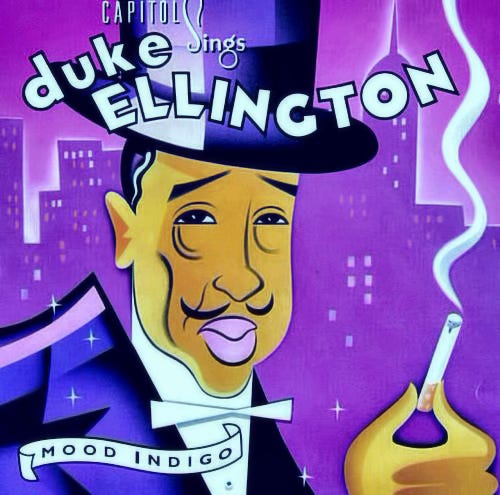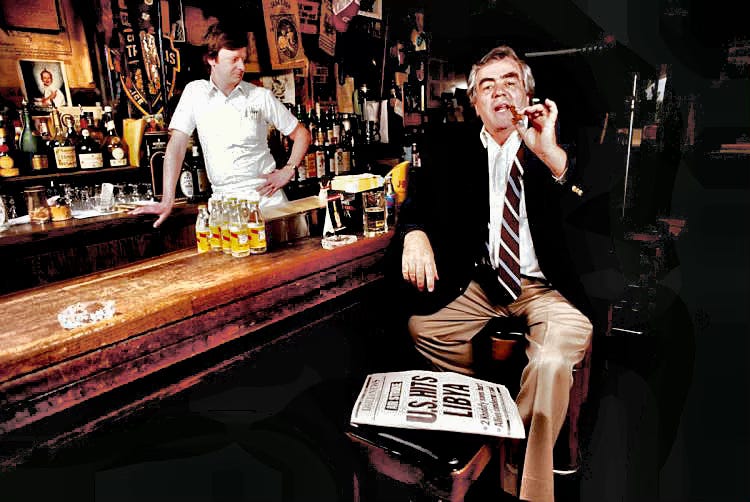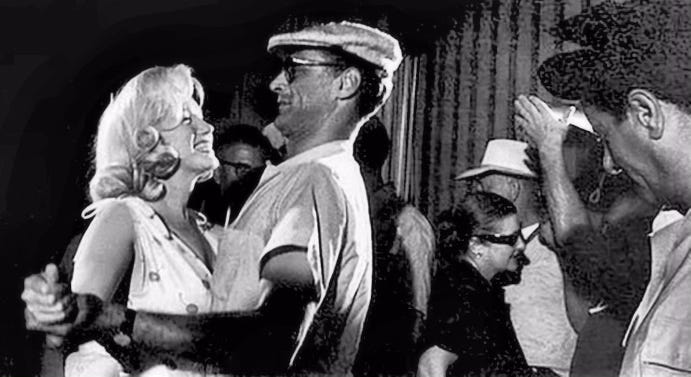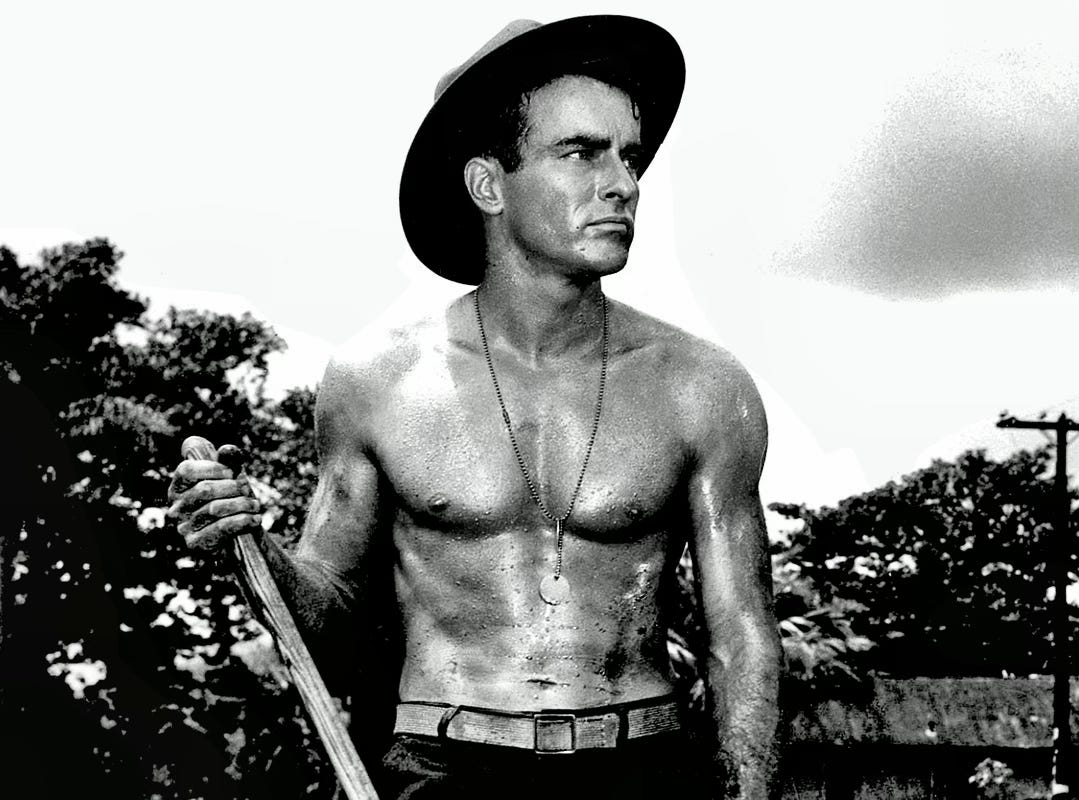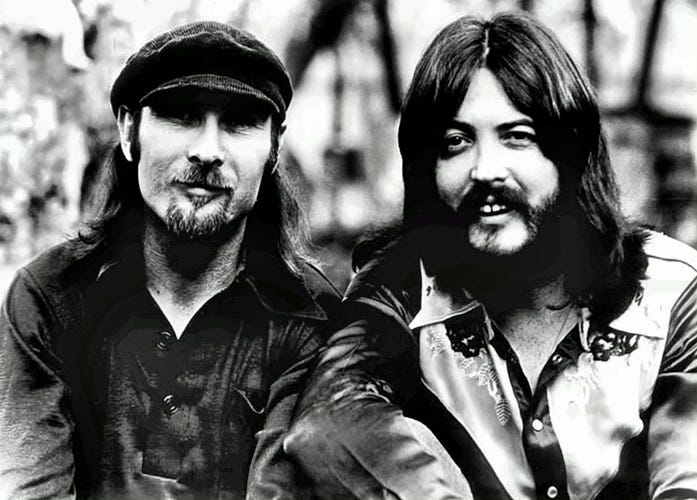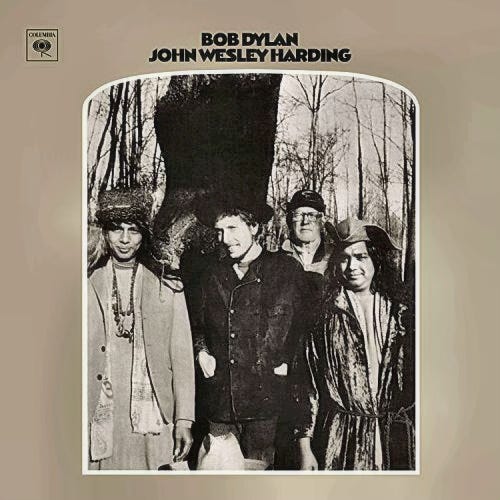On this day in 1930 — 93 years ago — Duke Ellington recorded "Mood Indigo.”
On this day in 1930 — 93 years ago — Duke Ellington recorded "Mood Indigo.”
The tune was composed for an Oct., 1930 radio broadcast and was originally titled "Dreamy Blues." It was "the first tune I ever wrote specially for microphone transmission," Ellington recalled. "The next day wads of mail came in raving about the new tune, so Irving Mills put a lyric to it."
Renamed "Mood Indigo," it became a jazz standard.
Ellington, a legendary composer and bandleader, was so famous for his poise and charm that it should be no surprise that he created a pithy story at the ready whenever he was asked about “Mood Indigo,” one of his most famous and enduring works. "Well, I wrote that in 15 minutes while I was waiting for my mother to finish cooking dinner," Ellington claimed.
As neatly as that version fit with his well-tended reputation for effortless sophistication, the true account of the song's development reflects the gifts for collaboration and adaptation that were always critical elements of Ellington's genius.
The genesis of "Mood Indigo" was a visit to New York City in 1930 by a New Orleans jazzman, Lorenzo Tio, Jr. Ellington's clarinetist, Barney Bigard, was a former student of Tio's, and on Tio's visit to New York, he shared with Bigard a number of melodies he'd written, including one called "Dreamy Blues" that had served as the theme song for his group back home, Armand Piron's New Orleans Orchestra.
"I asked him if I could borrow it," Bigard later wrote in his autobiography. "I took it home and kept fooling around with it...and got something together that mostly was my own but partly Tio's."
Bigard's variation on "Dreamy Blues" would soon become the clarinet solo on "Mood Indigo," thanks to Duke Ellington's penchant for involving his band members in his composition process.
Indeed, the lyricist Ervin Drake would later refer to Ellington's orchestra as a kind of "musical kibbutz" — an environment in which all ideas were welcomed and collaboration was the rule rather than the exception.
Taking Bigard and Tio's melody and composing a song of his own on top of it, Ellington created "Mood Indigo." It wasn't the elegance of the composition alone, however, that made the song Ellington's first big hit. It was the completely unexpected voicing of the horns in Ellington's original arrangement of the song. The clarinet, trumpet and trombone were generally arranged, in that order, from highest pitch to lowest in jazz music.
But Ellington turned the typical structure upside down on "Mood Indigo," using the clarinet near the bottom and the muted trombone near the top of its register. The arrangement also produced interesting overtones with the electronic microphones of the day.
With lyrics added by Mitchell Parish in 1931 (but credited to Ellington's manager, Irving Mills), "Mood Indigo" became a vocal-jazz standard as well as an instrumental one, recorded memorably by Ella Fitzgerald, Frank Sinatra and Nina Simone among many others.
Thanks History.com
Duke Ellington introduces “Mood Indigo.”
Jimmy Breslin at his office in a bar
Photo by Michael Brennan
Jimmy Breslin was born 95 years ago today.
A Pulitzer Prize-winning journalist and author, Breslin wrote numerous novels. His columns appeared regularly in various newspapers in his hometown of New York City. He served as a regular columnist for the Long Island, N.Y. newspaper, Newsday, until his retirement on November 2, 2004, though he still published occasional pieces for the paper until his death.
Born in Jamaica, New York, Breslin was also columnist for the New York Herald Tribune, the Daily News, the New York Journal American and other venues. When the Sunday supplement of the Tribune was reworked into New York magazine by editor Clay Felker in 1962, Breslin appeared in the new edition, which became "the hottest Sunday read in town."
Breslin was married, since 1982, to former New York City Council member, Ronnie Eldridge.
One of his best known columns was published the day after John F. Kennedy's funeral and focused on the man who had dug the president's grave. The column is indicative of Breslin's style, which often highlights how major events or the actions of those considered "newsworthy" affect the "common man."
Breslin's public profile in the 1960s as a regular guy led to a brief stint as a TV pitchman for Piels Beer, including a bar room commercial where he intoned in his deep voice: "Piels — it's a good drinkin' beer!"
In 1969, Breslin ran for president of the New York City Council in tandem with Norman Mailer, who was seeking election as mayor, on the unsuccessful independent 51st State ticket advocating secession of the city from the rest of the state. His memorable quote from the experience: "I am mortified to have taken part in a process that required bars to be closed."
His career as an investigative journalist led him to cultivate ties with various Mafia and criminal elements in the city, not always with positive results. In 1970, he was viciously attacked and beaten at The Suite, a restaurant then owned by Lucchese crime family associate, Henry Hill.
The attack was carried out by the mobster, Jimmy Burke, who objected to an article Breslin had written involving another member of the Lucchese family, Paul Vario. Breslin suffered a major concussion and nose bleeding, but survived the ordeal without any permanent injury.
In 1977, at the height of the Son of Sam scare in New York City, the killer, who was later identified as David Berkowitz, addressed letters to Breslin. Excerpts from these were published and later used in the Spike Lee film, Summer of Sam. Breslin played himself in the movie.
Breslin died from pneumonia on March 19, 2017, at his home in Manhattan. He was 88.
Arthur Miller dances with his wife, Marilyn Monroe, on the completion of The Misfits, 1960
Arthur Miller, playwright, was born 108 years ago today.
Among Miller’s most popular plays are All My Sons (1947), Death of a Salesman (1949), The Crucible (1953) and A View from the Bridge (1955, revised 1956).
He also wrote several screenplays and was most noted for his work on The Misfits (1961). The drama, Death of a Salesman, has been on the short list of finest American plays in the 20th century alongside Long Day's Journey into Night and A Streetcar Named Desire.
Miller was often in the public eye, particularly during the late 1940s, 1950s and early 1960s. During this time, he was awarded the Pulitzer Prize for Drama; testified before the House Un-American Activities Committee and was married to Marilyn Monroe.
Montgomery Clift, film and stage actor, was born 103 years ago today.
Clift was noted for his portrayal of "moody, sensitive young men" is his obituary by the New York Times. He often played outsiders and "victim-heroes.”
Cliff played the social climber in George Stevens's A Place in the Sun; the anguished Catholic priest in Hitchcock's I Confess; the doomed regular soldier Robert E. Lee Prewitt in Fred Zinnemann's, From Here to Eternity; and the Jewish GI bullied by anti-semites in Edward Dmytryk's, The Young Lions.
Later, after a disfiguring car crash in 1956, and alcohol and prescription drug abuse, he became erratic. Nevertheless, he continued his acting career, playing such parts as "the reckless, alcoholic, mother-fixated rodeo performer" in John Huston's The Misfits.
Marilyn Monroe, a co-star in the film who was also having emotional and substance abuse problems at the time, famously described Clift in a 1961 interview as "the only person I know who is in even worse shape than I am."
In 1961, with the scars still visible from the 1956 car crash, Clift gave a stunning portrayal of Rudolph Peterson, an emotionally unstable and physically tortured concentration camp victim in the Stanley Kramer film, Judgment at Nuremberg.
The performance earned Clift a nomination for an Academy Award for Best Supporting Actor. Clift received four Academy Award nominations during his career, three for Best Actor and one for Best Supporting Actor.
On July 22, 1966, Clift spent most of the hot summer day in his bedroom in his New York City townhouse, located at 217 East 61st Street. He and his live-in personal secretary, Lorenzo James, had not spoken much all day.
Shortly before 1:00 a.m., James went up to say goodnight to Clift, who was still awake and sitting up in his bed. James asked Clift if he needed anything and Clift politely refused and then told James that he would stay up for a while either to read a book or watch some television.
James then noted that his film, The Misfits, was on television that night airing as a late-night movie, and he asked Clift if he wanted to watch it with him. "Absolutely not!" was the firm reply. This was the last time Montgomery Clift spoke to anyone.
James went to his own bedroom to sleep without saying another word to Clift. At 6:30 a.m. the next day, James woke up and went to wake Clift, but found the bedroom door closed and locked.
James became more concerned when Clift did not respond to his knocking on the door. Unable to break the door down, James ran down to the back garden and climbed up a ladder to enter through the second-floor bedroom window.
Inside, he found Clift dead. He was undressed, lying on his back in bed, with eyeglasses on and both fists clenched by his side. James then used the bedroom telephone to call the police and an ambulance.
Clift's body was taken to the city morgue less than two miles away at 520 First Avenue and autopsied. The autopsy report cited the cause of death as a heart attack brought on by "occlusive coronary artery disease." No evidence was found that suggested foul play or suicide.
An underactive thyroid was later revealed. The condition (among other things) lowers blood pressure. It may have caused Clift to appear drunk or drugged when he was sober.
Here is Clift in a scene from The Misfits, 1961.
Jim Seals of Seals and Crofts was born 82 years ago today.
The rock duo, Seals and Crofts, was made up of Seals and Darrell "Dash" Crofts, who is now 80. They are best known for their Hot 100 #6 hits "Summer Breeze," "Diamond Girl" and "Get Closer."
The duo disbanded in 1980. They reunited briefly in 1991–1992 and again in 2004, when they released their final album, Traces. Both members have long been public advocates of the Bahá'í Faith.
Jim Seals and Dash Crofts were both born in Texas — Seals in Sidney and Crofts in Cisco. They first met when Crofts was a drummer for a local band. Later, Seals joined a band, Dean Beard and the Crew Cuts, where he played guitar. Crofts joined the band later.
With Beard, they moved to Los Angeles to join The Champs, but the two did so only after the group's "Tequila" reached #1 in 1958. Seals also spent time during 1959 in the touring band of Eddie Cochran.
In 1963, Jimmy Seals, Dash Crofts, Glen Campbell and Jerry Cole left The Champs to form a band, Glen Campbell and the GCs, which played at The Crossbow in Van Nuys.
The band only lasted a couple of years before the members went their separate ways. Crofts returned to Texas and Seals joined a band named The Dawnbreakers.
After the failure of The Dawnbreakers, the two decided to play as a duo, with Seals on guitar, saxophone and violin, and Crofts on guitar and mandolin.
They signed a contract with the record division of Talent Associates (TA) in 1969 and released two LPs, of which, only the second reached the Billboard 200 chart, peaking at #122 in October, 1970.
The pair signed a new contract with Warner Bros. Records in August, 1971. Their first album with their new label did not break into the charts, but their second album, Summer Breeze, charted at #7 in 1972. It sold over a million copies.
Seals is the brother of "England" Dan Seals, of England Dan & John Ford Coley, and later a well known country music star. Dan Seals died of cancer in 2009.
At the time of his death, Dan and Jimmy Seals had been working on songs together. The status of those recordings is unknown.
Seals died on June 6, 2022 at the age of 80.
Jim Seals of Seals and Crofts was born 82 years ago today.
The rock duo, Seals and Crofts, was made up of Seals and Darrell "Dash" Crofts, who is now 80. They are best known for their Hot 100 #6 hits "Summer Breeze," "Diamond Girl" and "Get Closer."
The duo disbanded in 1980. They reunited briefly in 1991–1992 and again in 2004, when they released their final album, Traces. Both members have long been public advocates of the Bahá'í Faith.
Jim Seals and Dash Crofts were both born in Texas — Seals in Sidney and Crofts in Cisco. They first met when Crofts was a drummer for a local band. Later, Seals joined a band, Dean Beard and the Crew Cuts, where he played guitar. Crofts joined the band later.
With Beard, they moved to Los Angeles to join The Champs, but the two did so only after the group's "Tequila" reached #1 in 1958. Seals also spent time during 1959 in the touring band of Eddie Cochran.
In 1963, Jimmy Seals, Dash Crofts, Glen Campbell and Jerry Cole left The Champs to form a band, Glen Campbell and the GCs, which played at The Crossbow in Van Nuys.
The band only lasted a couple of years before the members went their separate ways. Crofts returned to Texas and Seals joined a band named The Dawnbreakers.
After the failure of The Dawnbreakers, the two decided to play as a duo, with Seals on guitar, saxophone and violin, and Crofts on guitar and mandolin.
They signed a contract with the record division of Talent Associates (TA) in 1969 and released two LPs, of which, only the second reached the Billboard 200 chart, peaking at #122 in October, 1970.
The pair signed a new contract with Warner Bros. Records in August, 1971. Their first album with their new label did not break into the charts, but their second album, Summer Breeze, charted at #7 in 1972. It sold over a million copies.
Seals is the brother of "England" Dan Seals, of England Dan & John Ford Coley, and later a well known country music star. Dan Seals died of cancer in 2009.
At the time of his death, Dan and Jimmy Seals had been working on songs together. The status of those recordings is unknown.
Seals died on June 6, 2022 at the age of 80.
Here, Seals and Crofts perform “Summer Breeze.”
William Hogarth’s painting, “Gin Lane”
With all the recent news of destructive weather caused by climate change, it a day to recall another kind of flood — the London Beer Flood — that took the lives of eight people on Oct. 17, 1814 — 209 years ago today.
The flood happened in a densely populated slum known as St. Giles Rookery in England. A series of vats holding 323,000 imperial gallons of beer exploded at a brewery, breaking through a wall. Witnesses described a wave of porter ale and debris up to 15 feet high.
An “immense mass of ruins” is how one newspaper described the scene. The wave of beer destroyed two homes and crumbled the wall of the Tavistock Arms Pub, trapping teenage employee Eleanor Cooper under the rubble.
Within minutes neighboring George Street and New Street were swamped with alcohol, killing a mother and daughter who were drinking tea, and surging through a room of people gathered for a wake.
Decades earlier, the poverty of St. Giles inspired the painting, Gin Lane, by the artist William Hogarth. Perhaps because of the neighborhood’s reputation, accounts of onlookers trying to scoop up the free booze became part of the tragedy’s lore.
The brewery was demolished in 1922, and today, the Dominion Theatre occupies a part of the site of the former brewery. In 2012, a local tavern, the Holborn Whippet, began to mark the anniversary of the flood with a vat of porter brewed especially for the day.
Thanks New York Times!
Jean Arthur, actress and a major film star of the 1930s and 1940s, was born 123 years ago today.
Arthur had feature roles in three Frank Capra films — Mr. Deeds Goes to Town (1936), You Can't Take It With You (1938) and Mr. Smith Goes to Washington (1939). All the films championed her as the "everyday heroine."
Arthur was nominated for an Academy Award for Best Actress in 1944 for her performance in The More the Merrier (1943).
"No one was more closely identified with the screwball comedy than Jean Arthur. So much was she part of it, so much was her star personality defined by it, that the screwball style itself seems almost unimaginable without her," James Harvey wrote in his recounting of the era.
Arthur has been called "the quintessential comedic leading lady." Her last film performance was the memorable, and distinctly non-comedic, rancher's wife in George Stevens' Shane in 1953.
To the public, Arthur was known as a reclusive woman. "Next to Garbo, Jean Arthur is Hollywood's reigning mystery woman," wrote Life, the news magazine, in 1940. As well as recoiling from interviews, she avoided photographers and refused to become a part of any kind of publicity.
Arthur died at age 90 in 1991.
Here is Arthur and Joel McCrea in The More the Merrier, 1943.
Women boxing on a rooftop in Los Angeles, 1933
Photographer is unknown.
All the women are wearing dance shoes so they are probably performers for a variety show. Since no one had decent air conditioning back then, practicing their acts outside on the roof was better than in a stuffy theater.
Someone must have thought it’d make a good candid photo. The blonde girl is probably hitting her, but more of a stunt punch than a real one.
The original caption reads: Radio Pictures Chorus Girls. The theme of this picture is young, attractive women, dancers, exercising in the manner associated with men, which would have been an unusual thing for a woman to do in that time (especially the boxing obviously).
The photo was taken on the top of Ball Building, Paramount lot, Hollywood.
Before that particular lot was the Paramount studio, it was the Desilu studio, and before that, it was RKO (Radio-Keith-Orpheum). RKO Radio Pictures Inc. was one of the Big Five studios of Hollywood’s Golden Age.
They made some notable films in the 1930s and ’40s. During the 1930s RKO produced the well-known Fred Astaire-Ginger Rogers series of musicals and the early films of Katharine Hepburn.
Among RKO’s other better-known films were King Kong (1933), one of the first monster films and Orson Welles’s Citizen Kane (1941), now considered a masterpiece in cinema techniques.
In 1948, the businessman and producer Howard Hughes bought RKO, but his inattention and growing reclusiveness doomed the company; it ceased production in 1953.



